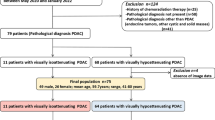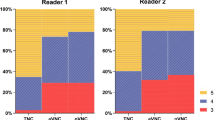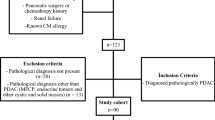Abstract
Objectives
To evaluate the image quality and optimal energies of virtual monoenergetic images (VMIs) from dual-layer spectral detector computed tomography (DLCT) in multiphasic pancreatic CT and investigate whether low-keV VMI at the portal venous phase (PVP) provides sufficient tumor conspicuity and arterial depiction relative to conventional pancreatic parenchymal phase (PPP) images.
Methods
Forty-eight patients with pancreatic ductal adenocarcinoma (PDAC) underwent contrast-enhanced DLCT during PPP and PVP. Conventional polyenergetic images (PEIs) and VMI at 40–100 keV (VMI40–100, 10-keV increments) were reconstructed at each enhancement phase. Image noise and the contrast-to-noise ratio (CNR) of the pancreas, tumors, arteries, and veins were quantified. Two radiologists independently assessed tumor conspicuity, margin delineation, image noise, sharpness of pancreatic duct, and depiction of arteries and veins on a five-point scale. Size-specific dose estimate (SSDE) was calculated.
Results
Image noise for VMI40–100 was significantly lower than that for PEI (p < 0.01). The CNR in VMI increased gradually with decreasing energy; CNRs for VMI40–60 were significantly greater than that for PEI (p < 0.01). All subjective VMI scores were maximized at VMI40, followed by VMI50–60, all of which were significantly better than of PEI (p < 0.01). Objective and subjective image qualities of VMI40–50 at the PVP were equivalent to or even better compared with conventional PPP images. No significant difference in SSDE was observed between phases (p = 0.10).
Conclusions
DLCT-VMI improved the subjective and objective image quality in multiphasic pancreatic CT for patients with PDAC. Low-keV PVP imaging may yield diagnostically adequate tumor conspicuity and arterial assessment compared with polyenergetic PPP images.
Key Points
• Low-keV VMI from DLCT yields better subjective and objective image quality of multiphasic pancreas CT in comparison with conventional PEI for the assessment of pancreatic ductal adenocarcinoma.
• Tumor conspicuity and depiction of peripancreatic vasculature were maximized at VMI 40 without an increase in the image noise.
• Low-keV VMI of the portal venous phase provides sufficient tumor conspicuity and arterial depiction, potentially allowing the early detection and local staging of PDAC on routine abdominal CT performed for various clinical indications.





Similar content being viewed by others
Abbreviations
- CNR:
-
Contrast-to-noise ratio
- CTDIvol :
-
Volume CT dose index
- DECT:
-
Dual-energy CT
- DLCT:
-
Dual-layer spectral detector CT
- PDAC:
-
Pancreatic ductal adenocarcinoma
- PEI:
-
Polyenergetic image
- PPP:
-
Pancreatic parenchymal phase
- PVP:
-
Portal venous phase
- ROI:
-
Region of interest
- SSDE:
-
Size-specific dose estimate
- VMI:
-
Virtual monoenergetic imaging
References
Siegel RL, Miller KD, Jemal A (2019) Cancer statistics, 2019. CA Cancer J Clin 69:7–34
Konstantinidis IT, Warshaw AL, Allen JN et al (2013) Pancreatic ductal adenocarcinoma: is there a survival difference for R1 resections versus locally advanced unresectable tumors? What is a “true” R0 resection? Ann Surg 257:731–736
Somers I, Bipat S (2017) Contrast-enhanced CT in determining resectability in patients with pancreatic carcinoma: a meta-analysis of the positive predictive values of CT. Eur Radiol 27:3408–3435
Al-Hawary MM, Francis IR, Chari ST et al (2014) Pancreatic ductal adenocarcinoma radiology reporting template: consensus statement of the Society of Abdominal Radiology and the American Pancreatic Association. Radiology 270:248–260
Zaky AM, Wolfgang CL, Weiss MJ, Javed AA, Fishman EK, Zaheer A (2017) Tumor-vessel relationships in pancreatic ductal adenocarcinoma at multidetector CT: different classification systems and their influence on treatment planning. Radiographics 37:93–112
Marchegiani G, Todaro V, Boninsegna E et al (2018) Surgery after FOLFIRINOX treatment for locally advanced and borderline resectable pancreatic cancer: increase in tumour attenuation on CT correlates with R0 resection. Eur Radiol 28:4265–4273
Lu DS, Vedantham S, Krasny RM, Kadell B, Berger WL, Reber HA (1996) Two-phase helical CT for pancreatic tumors: pancreatic versus hepatic phase enhancement of tumor, pancreas, and vascular structures. Radiology 199:697–701
Ichikawa T, Erturk SM, Sou H et al (2006) MDCT of pancreatic adenocarcinoma: optimal imaging phases and multiplanar reformatted imaging. AJR Am J Roentgenol 187:1513–1520
Prokesch RW, Chow LC, Beaulieu CF, Bammer R, Jeffrey RB Jr (2002) Isoattenuating pancreatic adenocarcinoma at multi-detector row CT: secondary signs. Radiology 224:764–768
Ishigami K, Yoshimitsu K, Irie H et al (2009) Diagnostic value of the delayed phase image for iso-attenuating pancreatic carcinomas in the pancreatic parenchymal phase on multidetector computed tomography. Eur J Radiol 69:139–146
Falck C, Galanski M, Shin H-o (2010) Informatics in radiology: sliding-thin-slab averaging for improved depiction of low-contrast lesions with radiation dose savings at thin-section CT. Radiographics 30:317–326
Yanaga Y, Awai K, Nakayama Y et al (2007) Pancreas: patient body weight tailored contrast material injection protocol versus fixed dose protocol at dynamic CT. Radiology 245:475–482
Kondo H, Kanematsu M, Goshima S et al (2007) MDCT of the pancreas: optimizing scanning delay with a bolus-tracking technique for pancreatic, peripancreatic vascular, and hepatic contrast enhancement. AJR Am J Roentgenol 188:751–756
Marin D, Nelson RC, Barnhart H et al (2010) Detection of pancreatic tumors, image quality, and radiation dose during the pancreatic parenchymal phase: effect of a low-tube-voltage, high-tube-current CT technique--preliminary results. Radiology 256:450–459
Loizou L, Albiin N, Leidner B et al (2016) Multidetector CT of pancreatic ductal adenocarcinoma: effect of tube voltage and iodine load on tumour conspicuity and image quality. Eur Radiol 26:4021–4029
Lin X-Z, Machida H, RT IT et al (2014) CT of the pancreas: comparison of image quality and pancreatic duct depiction among model-based iterative, adaptive statistical iterative, and filtered back projection reconstruction techniques. Abdom Imaging 39:497–505
Yamamura S, Oda S, Utsunomiya D et al (2013) Dynamic computed tomography of locally advanced pancreatic cancer: effect of low tube voltage and a hybrid iterative reconstruction algorithm on image quality. J Comput Assist Tomogr 37:790–796
Patel BN, Thomas JV, Lockhart ME, Berland LL, Morgan DE (2013) Single-source dual-energy spectral multidetector CT of pancreatic adenocarcinoma: optimization of energy level viewing significantly increases lesion contrast. Clin Radiol 68:148–154
Frellesen C, Fessler F, Hardie AD et al (2015) Dual-energy CT of the pancreas: improved carcinoma-to-pancreas contrast with a noise-optimized monoenergetic reconstruction algorithm. Eur J Radiol 84:2052–2058
Hardie AD, Picard MM, Camp ER et al (2015) Application of an advanced image-based virtual Monoenergetic reconstruction of dual source dual-energy CT data at low keV increases image quality for routine pancreas imaging. J Comput Assist Tomogr 39:716–720
McNamara MM, Little MD, Alexander LF, Carroll LV, Beasley TM, Morgan DE (2015) Multireader evaluation of lesion conspicuity in small pancreatic adenocarcinomas: complimentary value of iodine material density and low keV simulated monoenergetic images using multiphasic rapid kVp-switching dual energy CT. Abdom Imaging 40:1230–1240
Bellini D, Gupta S, Ramirez-Giraldo JC et al (2017) Use of a noise optimized monoenergetic algorithm for patient-size independent selection of an optimal energy level during dual-energy CT of the pancreas. J Comput Assist Tomogr 41:39–47
Bhosale P, Le O, Balachandran A, Fox P, Paulson E, Tamm E (2015) Quantitative and qualitative comparison of single-source dual-energy computed tomography and 120-kVp computed tomography for the assessment of pancreatic ductal adenocarcinoma. J Comput Assist Tomogr 39:907–913
Beer L, Toepker M, Ba-Ssalamah A et al (2019) Objective and subjective comparison of virtual monoenergetic vs. polychromatic images in patients with pancreatic ductal adenocarcinoma. Eur Radiol. https://doi.org/10.1007/s00330-019-06116-9
Kalisz K, Rassouli N, Dhanantwari A, Jordan D, Rajiah P (2018) Noise characteristics of virtual monoenergetic images from a novel detector-based spectral CT scanner. Eur J Radiol 98:118–125
Nagayama Y, Nakaura T, Oda S et al (2018) Dual-layer DECT for multiphasic hepatic CT with 50 percent iodine load: a matched-pair comparison with a 120 kVp protocol. Eur Radiol 28:1719–1730
Sellerer T, Noel PB, Patino M et al (2018) Dual-energy CT: a phantom comparison of different platforms for abdominal imaging. Eur Radiol 28:2745–2755
Christner JA, Braun NN, Jacobsen MC, Carter RE, Kofler JM, McCollough CH (2012) Size-specific dose estimates for adult patients at CT of the torso. Radiology 265:841–847
Hickethier T, Iuga AI, Lennartz S et al (2018) Virtual monoenergetic images from a novel dual-layer spectral detector computed tomography scanner in portal venous phase: adjusted window settings depending on assessment focus are essential for image interpretation. J Comput Assist Tomogr 42:350–356
Almeida RR, Lo GC, Patino M, Bizzo B, Canellas R, Sahani DV (2018) Advances in pancreatic CT imaging. AJR Am J Roentgenol 211:52–66
Sakabe D, Funama Y, Taguchi K et al (2018) Image quality characteristics for virtual monoenergetic images using dual-layer spectral detector CT: comparison with conventional tube-voltage images. Phys Med 49:5–10
Nagayama Y, Iyama A, Oda S et al (2019) Dual-layer dual-energy computed tomography for the assessment of hypovascular hepatic metastases: impact of closing k-edge on image quality and lesion detectability. Eur Radiol 29:2837–2847
Grosse Hokamp N, Obmann VC, Kessner R et al (2018) Improved visualization of hypodense liver lesions in virtual monoenergetic images from spectral detector CT: proof of concept in a 3D-printed phantom and evaluation in 74 patients. Eur J Radiol 109:114–123
Nagayama Y, Nakaura T, Oda S et al (2018) Dual-layer detector CT of chest, abdomen, and pelvis with a one-third iodine dose: image quality, radiation dose, and optimal monoenergetic settings. Clin Radiol 73:1058.e1021–1058.e1029
Brook OR, Gourtsoyianni S, Brook A, Siewert B, Kent T, Raptopoulos V (2013) Split-bolus spectral multidetector CT of the pancreas: assessment of radiation dose and tumor conspicuity. Radiology 269:139–148
Hickethier T, Byrtus J, Hauger M et al (2018) Utilization of virtual mono-energetic images (MonoE) derived from a dual-layer spectral detector CT (SDCT) for the assessment of abdominal arteries in venous contrast phase scans. Eur J Radiol 99:28–33
Lohofer FK, Kaissis GA, Koster FL et al (2018) Improved detection rates and treatment planning of head and neck cancer using dual-layer spectral CT. Eur Radiol 28:4925–4931
Zopfs D, Lennartz S, Laukamp K et al (2018) Improved depiction of atherosclerotic carotid artery stenosis in virtual monoenergetic reconstructions of venous phase dual-layer computed tomography in comparison to polyenergetic reconstructions. Eur J Radiol 100:36–42
Fletcher JG, Wiersema MJ, Farrell MA et al (2003) Pancreatic malignancy: value of arterial, pancreatic, and hepatic phase imaging with multi-detector row CT. Radiology 229:81–90
Funding
The authors state that this work has not received any funding.
Author information
Authors and Affiliations
Corresponding author
Ethics declarations
Guarantor
The scientific guarantor of this publication is Yasuyuki Yamashita.
Conflict of interest
The authors of this manuscript declare no relationships with any companies.
Statistics and biometry
No complex statistical methods were necessary for this paper.
Informed consent
Written informed consent was waived by the Institutional Review Board.
Ethical approval
Institutional Review Board approval was obtained.
Methodology
• retrospective
• observational
• performed at one institution
Additional information
Publisher’s note
Springer Nature remains neutral with regard to jurisdictional claims in published maps and institutional affiliations.
Rights and permissions
About this article
Cite this article
Nagayama, Y., Tanoue, S., Inoue, T. et al. Dual-layer spectral CT improves image quality of multiphasic pancreas CT in patients with pancreatic ductal adenocarcinoma. Eur Radiol 30, 394–403 (2020). https://doi.org/10.1007/s00330-019-06337-y
Received:
Revised:
Accepted:
Published:
Issue Date:
DOI: https://doi.org/10.1007/s00330-019-06337-y




